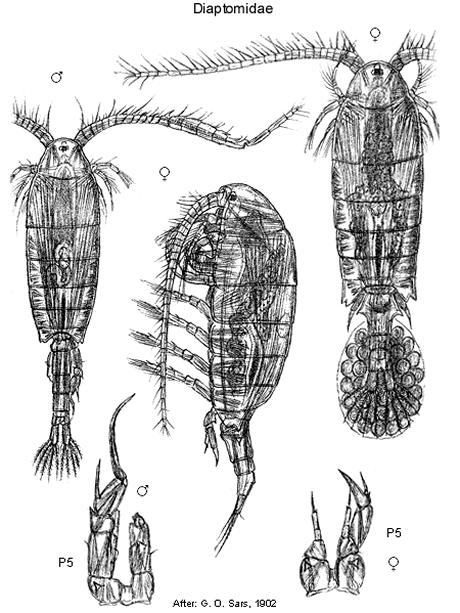 |
||||||
|
|
|
|
|
|
Calanoidea: FamiliesJ.M. Bradford-GrieveDiaptomidae Baird, 1850 Description. Female. Rostrum without filaments; rostral margin extends into 2 points. Cephalosome and pedigerous somite 1 separate; pedigerous somites 4 and 5 separate. Posterior corners of prosome in lateral view with 1 acute point, or divided into 2 protrusions; dorsal view symmetrical. Urosome with 2 free somites, or with 3 free somites. Genital double-somite symmetrical in dorsal view; gonopores close together and partially covered by single cuticular flap; without seminal receptacles. Caudal rami symmetrical. Mouthparts. Antenna 1 with 25 free segments. Antenna 2 exopod with 7 free segments; 12 setae; basis and endopod separate. Mandible basis with 3 setae; endopod terminal segment with 8 setae. Maxilla 1 basal exite seta present; exopod extends short of endopod distal border. Maxilla 2 coxal epipodite seta absent. Maxilliped coxal endite 2 with 2 setae. Legs. Leg 1 basis inner distal seta absent; outer seta absent; endopod with 2 segments; exopod with 3 segments; exopod segment 1 with outer distal spine; exopod segment 3 with 4 inner setae. Leg 2 endopod with 3 segments; exopod with 3 segments; exopod segment 3 with 1 outer spine. Leg 3 basis outer distal spine absent. Legs 3 and 4 endopod with 3 segments; exopod with 3 segments; exopod segment 3 with 1 outer spine; exopod segment 3 with 5 inner setae. Leg 4 endopod segment 3 with 7 setae. Legs 2-4 surfaces naked; terminal spine with outer border serrated. Leg 5 present; very dissimilar from legs 2-4; coxa inner border without seta; biramous but not natatory, may be slightly asymmetrical; coxae and intercoxal sclerite fused with outer distal tooth; basis with outer border seta; endopods 1-segmented, rod shaped; exopods 3-segmented, segment 1 cylindrical and unornamented, segment 2 tooth-like with inner border denticles and outer spinule, terminal segment very small and inserted subterminally bearing about 2 spinules. Mode of life. Pelagic, in freshwaters. Depth distribution. Epipelagic (0-500 m). Generic composition. This family contains about 50 genera although the status of some of them is not certain: Acanthodiaptomus Kiefer, 1932; Aglaodiaptomus Light, 1938; Allodiaptomus Kiefer, 1936; Arctodiaptomus Kiefer, 1932; Argyrodiaptomus Brehm, 1933; Calodiaptomus Kiefer, 1936; Copidodiaptomus Kiefer, 1968; Dactylodiaptomus Kiefer, 1936; Dentodiaptomus Shen & Tai, 1964; Diaptomus Westwood, 1836; Dolodiaptomus Shen & Tai, 1964; Dussartius Kiefer, 1978; Eodiaptomus Kiefer, 1932; Eudiaptomus Kiefer, 1932; Filipinodiaptomus Lai Mamaril & Fernando, 1978; Heliodiaptomus Kiefer, 1932; Hemidiaptomus Sars, 1903; Heliodiaptomus Kiefer, 1932; Hesperodiaptomus Light, 1938; Idiodiaptomus Kiefer, 1936; Leptodiaptomus Light, 1938; Ligulodiaptomus Shen & Tai, 1962; Lovenula Schmeil, 1898; Mastigodiaptomus Light, 1939; Megadiaptomus Kiefer, 1936; Metadiaptomus Methuen, 1910; Microdiaptomus Tafall, 1942; Mixodiaptomus Kiefer, 1932; Mongolodiaptomus Kiefer, 1932; Neodiaptomus Kiefer, 1932; Neutrodiaptomus Kiefer 1937; Nordodiaptomus Wilson, 1951; Notodiaptomus Kiefer, 1936; Odontodiaptomus Kiefer, 1936; Onychodiaptomus Light, 1939; Paradiaptomus Sars, 1895; Phyllodiaptomus Kiefer, 1936; Prionodiaptomus Light, 1939; Rhacodiaptomus Kiefer, 1936; Sinodiaptomus Kiefer, 1932; Skistodiaptomus Light, 1939; Spelaeodiaptomus Dussart, 1970; Speodiaptomus Borutsky, 1962; Spicodiaptomus Rajendran, 1973; Stigodiaptomus Petkovski, 1981; Thermodiaptomus Kiefer, 1932; Troglodiaptomus Petkovski, 1978; Tropodiaptomus Kiefer, 1932; Tumeodiaptomus Dussart, 1979; Zeylanodiaptomus Fernando & Hanek, 1976 (see Dussart & DeFaye, 1983).
(Variant) Male (sexually dimorphic characters). Description. Male. Pedigerous somites 4 and 5 fused or partly fused, or separate. Posterior corners of prosome in dorsal view symmetrical, or asymmetrical. Mouthparts. Mouthparts well-developed. Antenna 1 geniculate on right. Maxilliped endopod segments 5 and 6 with outer setae normal. Legs. Right leg 5 biramous; endopod separate from basis and 1-segmented, or 2-segmented; exopod elongate, 3-segmented, segment 1 with outer distal spine, segment 2 with long spine on outer proximal border and sometimes additional spines and process, segment 3 curved, elongate and spine-like. Left leg 5 biramous; endopod 1-segmented, or 2-segmented; exopod short, 2-segmented, segment 1 naked, segment 2 very small with a few terminal spines.
Cite this publication as: 'Bradford-Grieve, J.M. (2002 onwards). Calanoida: families. Version 1: 2 October 2002. https://crustacea.net'. |
|
|
|
|
|
|
|
|
|
Copyright © Australian Museum, 2002 - 2003
Australian Museum website
